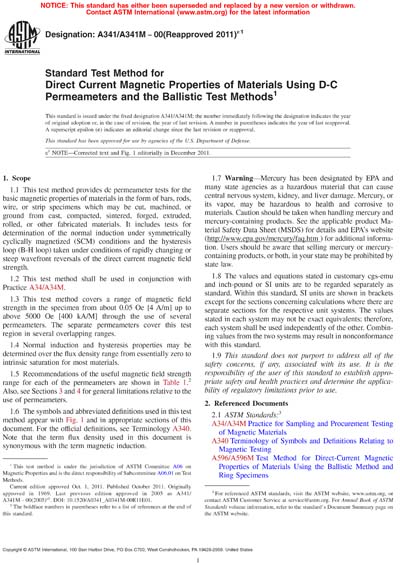Historical
ASTM A341/A341M-00(2011)e1
Standard Test Method for Direct Current Magnetic Properties of Materials Using D-C Permeameters and the Ballistic Test Methods
1.1 This test method provides dc permeameter tests for the basic magnetic properties of materials in the form of bars, rods, wire, or strip specimens which may be cut, machined, or ground from cast, compacted, sintered, forged, extruded, rolled, or other fabricated materials. It includes tests for determination of the normal induction under symmetrically cyclically magnetized (SCM) conditions and the hysteresis loop (B-H loop) taken under conditions of rapidly changing or steep wavefront reversals of the direct current magnetic field strength.
1.2 This test method shall be used in conjunction with Practice A34/A34M.
1.3 This test method covers a range of magnetic field strength in the specimen from about 0.05 Oe [4 A/m] up to above 5000 Oe [400 kA/M] through the use of several permeameters. The separate permeameters cover this test region in several overlapping ranges.
1.4 Normal induction and hysteresis properties may be determined over the flux density range from essentially zero to intrinsic saturation for most materials.
1.5 Recommendations of the useful magnetic field strength range for each of the permeameters are shown in Table 1 . Also, see Sections 3 and 4 for general limitations relative to the use of permeameters.
1.6 The symbols and abbreviated definitions used in this test method appear with Fig. 1 and in appropriate sections of this document. For the official definitions, see Terminology A340. Note that the term flux density used in this document is synonymous with the term magnetic induction.
1.7 Warning
1.8 The values and equations stated in customary cgs-emu and inch-pound or SI units are to be regarded separately as standard. Within this standard, SI units are shown in brackets except for the sections concerning calculations where there are separate sections for the respective unit systems. The values stated in each system may not be exact equivalents; therefore, each system shall be used independently of the other. Combining values from the two systems may result in nonconformance with this standard.
Content Provider
ASTM International [astm]






